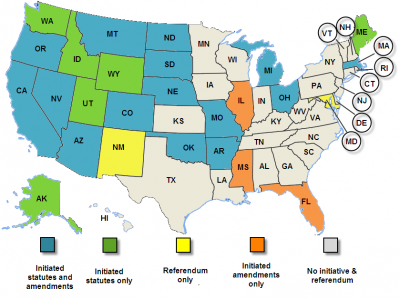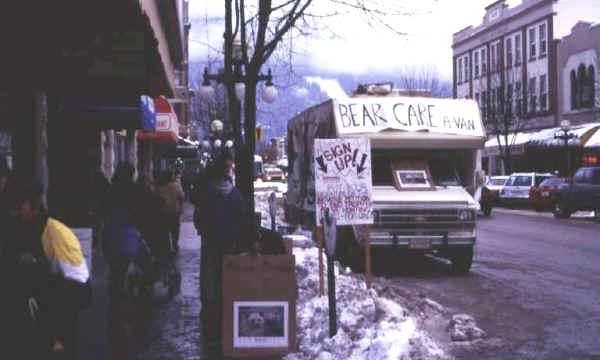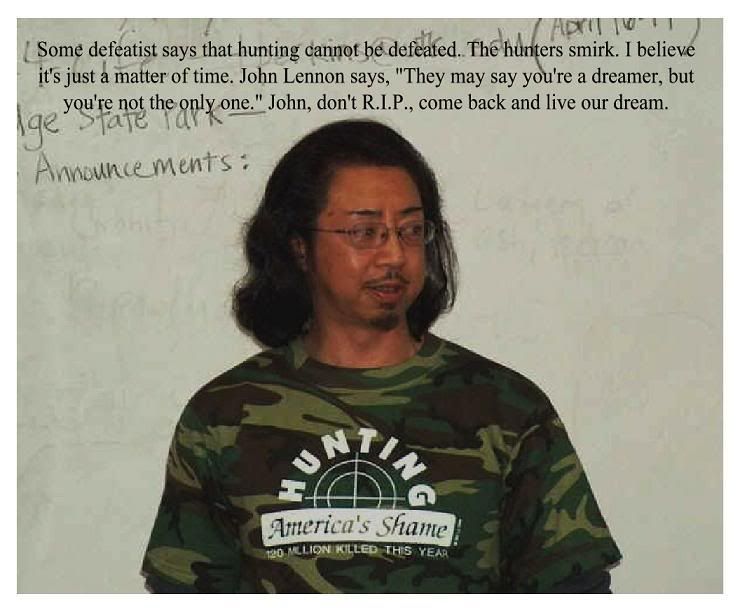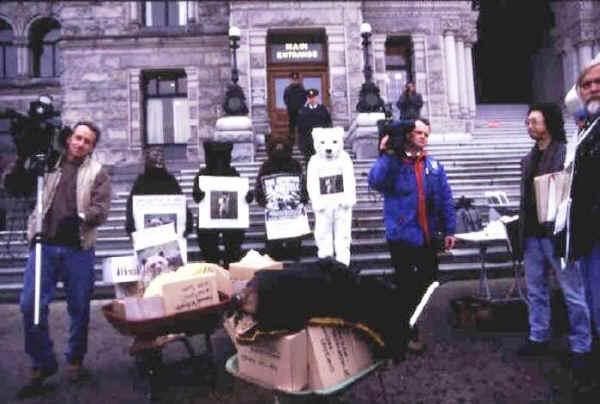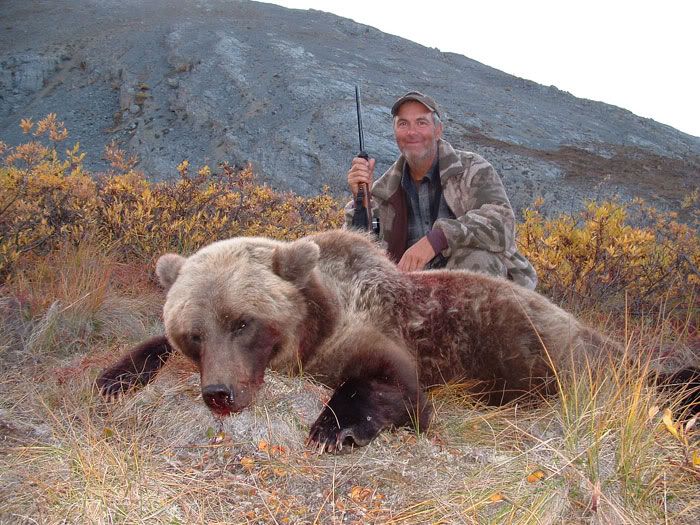1. It forced the enactment of the WAPPRIITA law in April 1996, rendering the selling of anything containing endangered species ingredients illegal within Canada.
2. It secured me a place in the 28,000-paying-members-strong Western Canada Wilderness Committee (WCWC), which had all the campaigning tools I as an individual did not have.
3. It won me a $75,000 project grant from the Canadian International Development Agency (CIDA) in 1997 to go to India to help save the Bengal tiger from extinction. This in turn expanded into a 3-year program grant of $100,000 per annum to return to India three times more in 1998, 1999 and 2000. From 1997 and 2000, the Western Canada Wilderness Committee, a regional environmental organization, waged an outstanding wildlife preservation campaign of global scope.
4. The campaign also became the "Champion of the Bengal Tiger" episode (1999) of the award-winning 5-year TV documentary series "Champions of The Wild" aired on Discovery Channel, Animal Planet and Knowledge Network in 20 countries around the world.
When I first got started in Chinatown, I had no idea where I was headed. Fate led me along my path, and tested me at every turn. It was always by free will, but also as if predestined, and in retrospect, seemed meant-to-be.
My three expeditions in India were high points in my life, and remain vivid in my memory a dozen years hence. What I did in India is encapsulated in this page:
http://www.all-creatures.org/hope/02%20deep%20rural%20India%20expeditions.htm
and outlined in the following article by me published in the Vancouver Sun:

[Anthony Marr with his trusted and beloved Indian colleague and friend Faiyaz Khudsar]
A Passionate Journey to Save India's Tigers
1999-05-14
Vancouver Sun
by Anthony Marr

VANCOUVER, British Columbia, Canada, May 14, 1999 (ENS) - The tigress was sleeping on her side in the undergrowth deep within Kanha National Park in Madhya Pradesh, the self-appointed "tiger state" of India. She was scarcely visible in the dense foliage with her camouflage of brown and white patches and shadowy black stripes. Within tail-flicking distance behind her was a half-eaten carcass of a wild boar. The tigress was not going anywhere, short of angrily bolting in fear of being stepped on by the elephant on which I was ensconced, which was indeed getting a little too close.
She tolerated our intrusion for awhile, but when the elephant ripped a branch off the tree in whose shade she was resting, she finally had enough, rolled on all fours, gave us a chilling glare and emitted a hissing snarl that could not be ignored. I snapped the last of a string of photos and instructed the mahout (elephant driver) to beat a prudent retreat.

It was January this year, during my third expedition to India's Kanha and Bandhavgarh tiger reserves as Western Canada Wilderness Committee's (WCWC) tiger conservation program director. The program, with WCWC working in partnership with the Indian conservation group Tiger Trust (TT), is funded by the Canadian International Development Agency at $100,000 per year over three years. WCWC also generates further tiger conservation funds from its own 25,000-strong membership, hundreds of donors, educational outreach slideshows and its annual Save-the-Tiger Walk.

Of the original 100,000 to 150,000 tigers worldwide, only 4,000 to 5,000 remain with only three of the original eight subspecies surviving. The Bali tiger was extinct as of the 1940s, the Caspian tiger died out in the 1970s and the Javan tiger in the 1980s. Of the remaining subspecies, the Indian Royal Bengal tiger has the best chance of survival because there are still about 2,500 remaining compared with 1,000 Indo-Chinese tigers, 300 Siberian tigers, 300 Sumatran tigers and 20 South China tigers.

Wild tigers are dying at the rate of about two each day worldwide due to the dual cause of direct killing and habitat loss. By the same token, about one a day dies in India. At these rates, no wild tiger will be left anywhere in the world within a decade, and the Indian tiger's security is but that of the last carriage of a crashing train - unless tiger conservation projects everywhere succeed big time, and very quickly. This is what I'm betting on, starting with our Save-the-Tiger Campaign.

In 1973 when Project Tiger was launched, with founder Kailash Sankhala as the first director, tiger trophy-hunting was banned and about 25 tiger reserves were created. Meanwhile, however, consumer countries like Japan, Korea and China continue to demand for more tiger bone and penis to supply their traditional medicine markets, and India's human and cattle populations continue to sky-rocket - 980 million and 500 million today respectively.

These are the dual causes of tiger decline - habitat loss and direct killing. Direct killing refers to poaching for medicinal bone and penis, but also poisoning by villagers in retaliation for the occasional loss of cattle as tiger prey. Habitat loss encompasses deforestation and overgrazing. Currently, the biological contents of a miniscule three percent of India's land mass are given any degree of protection, but even these "protected" areas are being eroded by government-condoned mining and logging, and by local villagers in desperate need of firewood for cooking and heating. Especially hard to solve is the overpopulation problem of India's cattle, caused by their being milk-producers, beasts of burden, and, most importantly, sacred cows.

For each of these problems there are long-term and short-term solutions. The long-term solution is to re-kindle citizen pride in the tiger as a national symbol throughout India and especially to motivate the villagers who live around tiger reserves to become tiger conservationists themselves.

This is easier said than done. While I was there, India was consumed by cricket fever. If Indian tiger conservation could captured but one percent of this enthusiasm, I could retire.

During my two-week stay in urban India, I gave our tiger conservation slideshow, seen by more than 30,000 students in British Columbia, to 3,000 students of ten Delhi and Jaipur schools. The show did generate the same degree of enthusiasm, resulting in ten "tiger clubs," which I aim to link with environmental clubs in schools in Canada.

What does it take to turn villagers into tiger conservationists? Consider first the villagers. During my eight-week stay in rural India, our WCWC/TT team, made up of TT field worker Faiyaz Khudsar, Vancouver volunteer Anne Wittman and myself, held six hour meetings with the leaders of about 120 villages of the 178 in Kanha's Buffer Zone. The meetings included discussion, a slideshow and a two hour safari in the park - a place most of them have never seen.

Their most common concerns are crop plundering by park ungulates especially the cheetal deer and the wild boar, loss of cattle to tiger, insufficient compensation for both, the lack of irrigation, and, last but not least, the lack of financial benefit from the park.

Underneath these external factors is the general undertone of abject poverty that limits the villagers' mindset to the here and now at the expense of tomorrow into which the path of conservation extends. The key to overcoming these difficulties is actually quite simple: to let long term conservation benefit them today.

One of the key components of this is to introduce alternative technologies, such as biogas plants and solar cookers, to replace wood as fuel. Bearing in mind that village women currently spend their daylight hours gathering fuelwood from far afield, then walking kilometers back to their villages or to townships to sell their 50 pound headloads for 15 rupees (55 cents) each, they would welcome alternatives that could allow them to stay at home and work on financially more rewarding and more eco-friendly cottage industries.

Our team trekked long distances through thick jungle in Kanha's Buffer Zone to access remote villages with our demo solar oven on one of our backs. The demo cooker was designed and made in Canada, but units are modified in India so they can be constructed out of local materials. With nine months of solid sunshine a year, India is well suited to this technology. In a multi-village conference at Bandhavgarh where I was one of the speakers, we signed up 23 villages who wished to try out our solar cooker, and further, five villagers signed up to learn to make the cooker on a commercial basis.

To combat the cattle overpopulation and overgrazing problem, we bought a special hybrid Haryanna bull that local people had been hankering for - one whose offspring yield ten times the amount of milk as the usual breeds. We provided it on a trial basis to a village named Chichrunpur on the periphery of Kanha tiger reserve - one of the 22 villages translocated from the Core Area into the Buffer Zone during the creation of the park. The villagers agreed to stall-feed the new bull and his offspring with fodder that can be grown on part of the land or obtained commercially, while gradually retiring the existing low quality stock and neutering all their existing random-bred bulls. After a generation two, the bull will be rotated to another village and another installed in his place. Stall-feeding is important because it frees the land from free-range overgrazing, protects the higher-quality animals from tiger predation, and makes cattle dung readily available for biogas (methane) generation - another alternative fuel technology.

Regarding the tiger reserves, the general sentiment of the villagers is that they are little more than rich peoples' playgrounds that provide little financial benefit to them save a few jobs in the park service, and worse, produce deer and wild boar that plunder half their crops without adequate compensation from the park authorities. In view of this, we recommended reforming the park system so that the reserves can at least compensate for themselves. Consider this: the world renowned Kruger National Park of South Africa charges $25 US per visit, Uganda charges US$180 for one hour of Mountain gorilla viewing. Neighbouring Nepal's Chitwan National Park grosses US$800,000 a year. Half goes to improve park services, including anti-poaching, and half goes to a benefit fund managed by the villages themselves, which helps to preserve the park as their benefactor.

In contrast, the Indian tiger reserves charge foreign tourists onlyUS$2.50 for a full day park visit. Indian visitors, mostly wealthy people from other states, pay just 25 cents. We advocate using Chitwan as a model by raising the park fee by a factor of ten for both foreign and out-of-state Indian tourists, while offering local villagers free park access on a limited basis. Half the increased revenue could go to park services which could generate more employment, and half could go to the villages to compensate for crop plundering and finance cottage industry enterprises such as manfacturing solar cookers. This gives the villagers a real control over their own destiny.

The park officials, villagers and tourists we have spoken with at both Kanha and Bandhavgarh by and large wholeheartedly embraced the proposal. We further pointed out that tigers are in fact their benefactors, since they keep the wild ungulate populations down by several thousand a year, and tigers are what tourists from around the world pay the park fee to see.

While at Bandhavgarh, we were dismayed to discovered that the tigress Sita, made world famous by the cover article in the December 1997 issue of National Geographic, had disappeared. Her loss is most likely due to poaching. More than five other tigers out of a supposed population of only 45 have also vanished, all within the last six months. The entire park was in a state of subdued uproar, with fingers pointed in various directions.

Only yesterday I heard from Faiyaz Khudsar that 10 tiger skins and four tiger skeletons were recently seized in the Kanha District capital Balaghat. Some officials would deny it, but commercial poaching is alive and well at both tiger reserves. The proposed park reform should strengthen their anti-poaching measures.

During our visit, we maintained the medical clinic and free school we installed at the Tiger Trust Conservation Centre at Kanha in 1997. The school and clinic services three nearby villages. In the whole of Kanha's Buffer Zone there are only four medical clinics including our own, all with similar effective ranges. Of the 178 Buffer Zone villages, no more than a dozen have access to any medical service.

For the rest, we introduce local medicinal plant cultivation and use by means of our demonstration medicinal plant garden. We intend to establish a mobile clinic to benefit more villages in due course.

From their perspective we are a foreign adjunct to the park system, and they likely would give some credit to the tiger reserves for any benefit they receive from us.

Finally, we can all learn something from India's experience. Tiger trophy hunting was not banned until there were fewer than 2,000 tigers left, in spite of which the Indian tiger may still perish. Currently, most independent biologists agree that there may be as few as 4,000 Grizzly bears in British Columbia, regardless of how many more the prohunting BC government claims there are. If we do not ban the Grizzly bear hunt here in our own backyard immediately, our Grizzly bears may go the same way as the highly endangered Indian tiger, or worse, the extinct Bali, Caspian and Javan tigers.

{Anthony Marr is the tiger campaign director for the Western Canada Wilderness Committee. His next expedition to India will depart from Vancouver in October or November. Anyone interested in volunteering can contact the Wilderness Committee at 604-683-8220 begin_of_the_skype_highlighting 604-683-8220 end_of_the_skype_highlighting
@ Environment News Service (ENS) 1999.

The following links and pictures will tell their own stories:
1997-2001 (AM's educational outreach - numerous newspaper articles)
http://www.all-creatures.org/hope/03%20urban%20India%20educational%20outreach.htm

1997-2004 (AM at various international conferences)
http://www.all-creatures.org/hope/02%20international%20conferences.htm
1997, Fall (WC Wilderness Committee publication - AM "Tiger tiger burning dim")
http://historic.wildernesscommittee.org/WILD/reports/Vol16No08

1999 (AM in Champions of the Wild - Bengal tiger), Part 1 & part 2
http://www.youtube.com/watch?v=-WRByqau1RY
http://www.myspace.com/video/vid/63713703
(Part 1.)
(Part 2.)
1999 (India Travelogue, India, honor-mentioning AM as an example)
http://www.all-creatures.org/hope/indiaexp-1999.htm
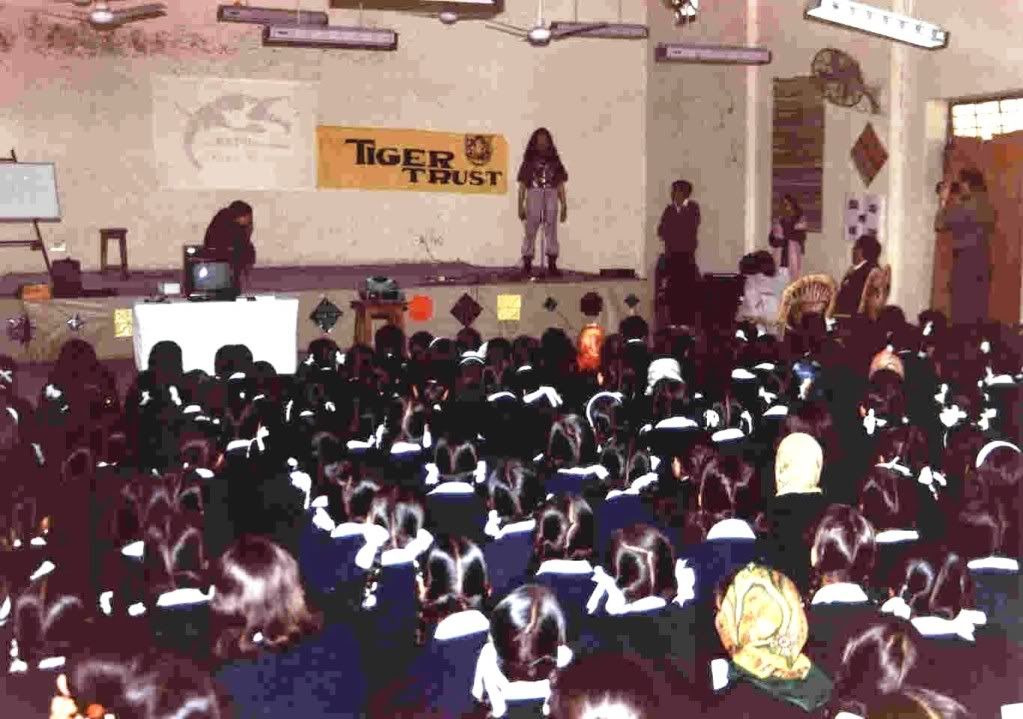
1999-02 (Article in Travel Talk magazine, India TT bureau, "Save The Tiger Campaign)
http://www.all-creatures.org/hope/indiaexp-199902.htm
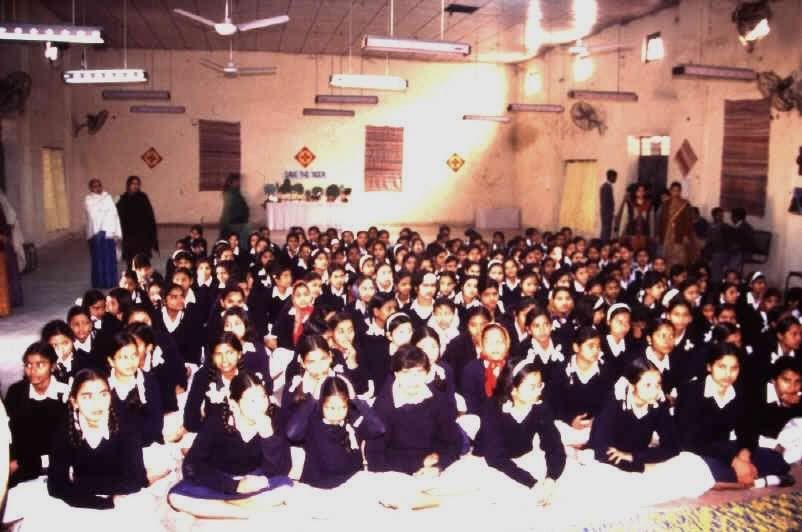
1999-02-12 (Article in The Hindu, National, India, "Need to Protect the Tiger Stressed")
http://www.all-creatures.org/hope/indiaexp-19990212-5.htm
1999-02-14 (The Asian Age, India - "Love the Tiger Walk in New Delhi today to save wild cats)
http://www.all-creatures.org/hope/indiaexp-19990214.htm
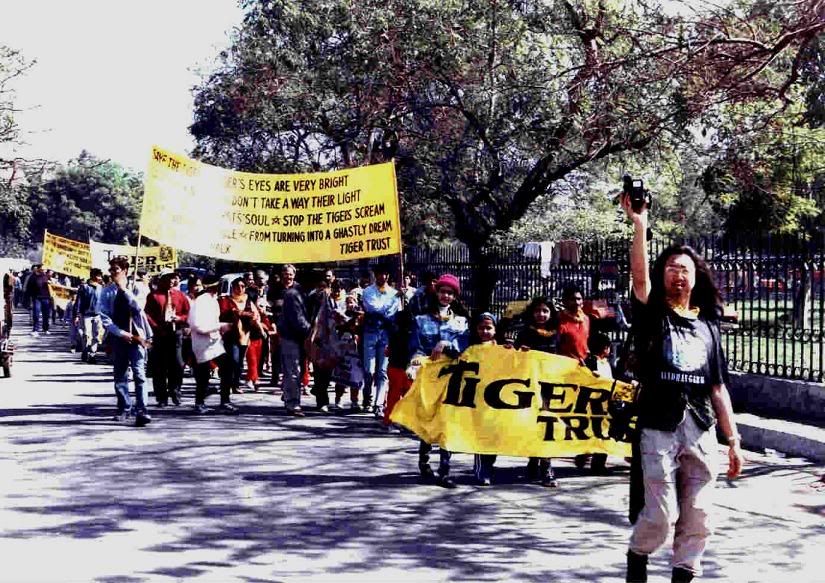
1999-02-15 (The Statesman, India, "A Valentine for the big cats")
http://www.all-creatures.org/hope/indiaexp-19990215.htm

1999-02-15 (The Hindu, National, India - "Valentine's Tiger Lovers")
http://www.all-creatures.org/hope/indiaexp-19990215-3.htm

1999-02-16 (Delhi Times and the Times of India - "He is no ordinary tiger")
http://www.all-creatures.org/hope/indiaexp-19990216.htm

1999-03-18 (The Hitavada, India - "Save Tigers from Extinction")
http://www.all-creatures.org/hope/indiaexp-19990318.htm

1999-05-14 (The Vancouver Sun - "A Passionate Journey to Save India's Tigers" by AM)
http://www.all-creatures.org/hope/indiaexp-19990514.htm

1999-06 (Tiger Link, India, global - "Love the Tiger Walk", New Delhi)
http://www.all-creatures.org/hope/indiaexp-19990514.htm

2000, Spring (Wilderness Committee report - AM in India project)
http://historic.wildernesscommittee.org/memberreport/reports/Vol19No01/tigers

Honorable mention are due to Faiyaz Khudsar (then Tiger Trust), Belinda Wright (Wildlife Protection Society of India - WPSI), Ashok Kumar (WPSI), Anne Witman (Canadian volunteer), Kim Poole (Canadian volunteer), Christopher Lindstrom (American volunteer).

Anthony Marr, Founder and President
Heal Our Planet Earth (HOPE)
Global Anti-Hunting Coalition (GAHC)
Anthony-Marr@HOPE-CARE.org
www.HOPE-CARE.org
www.facebook.com/Anthony.Marr.001
www.facebook.com/Global_Anti-Hunting_Coalition
www.myspace.com/AnthonyMarr
www.youtube.com/AnthonyMarr
www.HomoSapiensSaveYourEarth.blogspot.com
www.myspace.com/Anti-Hunting_Coalition
www.ARConference.org

